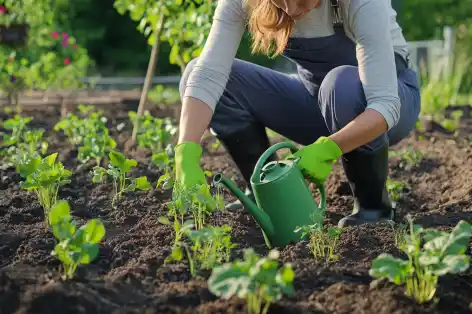Gardening is all about timing. To maximize your harvest, it’s essential to understand the growing seasons and plant the right vegetables at the right time. In this guide to seasonal vegetable gardening, we’ll cover the basics of seasonal planting, walk you through a month-by-month guide to what to plant, and provide tips for planning a successful garden year-round.
1. The Basics of Seasonal Vegetable Gardening
Seasonal vegetable gardening revolves around planting crops suited to the climate and time of year. This not only helps your plants thrive but also ensures a continuous harvest throughout the year.
1.1. Understanding the Growing Seasons
The growing seasons—spring, summer, fall, and winter—each offer unique opportunities to grow different types of vegetables. For example, cool-season crops like lettuce and spinach thrive in early spring and fall, while warm-season crops like tomatoes and peppers grow best in the heat of summer. Understanding the natural cycles of temperature and daylight will help you decide what to plant and when.
- Cool-Season Vegetables: Thrive in cooler temperatures (spring and fall).
- Warm-Season Vegetables: Prefer warmer temperatures and longer daylight hours (summer).
1.2. How Climate Affects Planting Times
Climate plays a huge role in determining the best time to plant vegetables. Gardeners in colder climates with shorter growing seasons will need to start seeds indoors or focus on cold-hardy crops, while those in warmer climates may have more flexibility to grow year-round. Understanding your USDA Hardiness Zone or local frost dates will help you create a planting schedule tailored to your region.
For tips on how to grow a successful organic garden no matter your climate, check out this guide on growing organic vegetables at home.

2. Preparing Your Garden for Each Season
Every season requires a different approach to garden preparation and maintenance. Proper planning and soil preparation are key to ensuring healthy crops throughout the year.
2.1. Soil Preparation and Mulching Tips
Before each planting season, focus on improving your soil health. Add compost or organic matter to boost nutrient levels and improve soil structure. In the cooler months, mulch your garden to retain moisture and insulate the soil. Mulching also suppresses weeds and reduces the need for frequent watering.
- Spring Preparation: Add compost and lightly till the soil to break up any compaction from winter.
- Fall Preparation: Use leaf mulch or straw to protect your soil during the cold months and prepare for winter crops.
2.2. Best Practices for Garden Maintenance Across Seasons
Year-round maintenance is essential for a successful garden. Remove weeds regularly, prune overgrown plants, and keep an eye out for pests that might affect your crops. As the seasons change, adjust your watering schedule and use season-specific techniques to ensure your garden thrives.

3. Month-by-Month Guide to What to Plant
Here’s a breakdown of what to plant each month to keep your garden productive throughout the year.
January – Cool-Weather Vegetables to Start Indoors
In January, start cool-weather crops indoors. These vegetables can be transplanted into your garden once the temperatures begin to warm up in early spring.
- What to plant: Broccoli, cauliflower, lettuce, and onions.
February – Early Spring Crops to Sow
By February, it’s time to sow early spring crops. These cool-season vegetables thrive in cooler temperatures and can be planted outside once the ground thaws.
- What to plant: Spinach, kale, peas, and radishes.
March – Preparing for a Bountiful Spring Garden
In March, start prepping your garden for spring planting. Transplant the cool-season vegetables you started indoors in January, and sow additional seeds for early spring crops.
- What to plant: Carrots, beets, Swiss chard, and potatoes.
April – Best Vegetables to Plant Outdoors
April is a great time to plant both cool-season and early warm-season vegetables outdoors, depending on your climate.
- What to plant: Lettuce, peas, beans, and tomatoes (if your region is frost-free).
May – Summer Vegetables to Get in the Ground
As temperatures rise, it’s time to plant your summer crops. These heat-loving vegetables need lots of sunlight and warm soil to thrive.
- What to plant: Tomatoes, cucumbers, squash, peppers, and corn.
June – Mid-Summer Planting Tips
June is the peak of the growing season. Continue planting warm-season vegetables while harvesting early crops.
- What to plant: Zucchini, melons, sweet potatoes, and basil.
July – Heat-Tolerant Vegetables for Late Summer
In July, focus on planting heat-tolerant vegetables and herbs that can handle the hot summer temperatures.
- What to plant: Eggplant, okra, peppers, and sunflowers.
August – Planning for a Fall Garden
As summer comes to an end, it’s time to start thinking about fall crops. Cool-season vegetables will thrive again as temperatures begin to drop.
- What to plant: Broccoli, cabbage, carrots, and turnips.
September – Best Vegetables for Fall Harvest
September is ideal for planting a second round of cool-weather crops that will mature before the first frost.
- What to plant: Spinach, lettuce, radishes, and peas.
October – Planting Cool-Season Crops
In October, plant crops that can tolerate cooler temperatures and might even improve in flavor after a light frost.
- What to plant: Garlic, onions, kale, and collard greens.
November – Preparing for Winter Gardening
November is all about preparing your garden for winter. Plant hardy winter crops and consider using row covers or cold frames to extend the growing season.
- What to plant: Brussels sprouts, leeks, and winter greens.
December – What to Sow in Colder Months
During the coldest months, focus on indoor gardening or protecting outdoor crops with row covers. This is also a great time to plan your garden for the coming year.
- What to plant: Microgreens, herbs, and winter greens.
For a detailed guide to help you get started with seasonal gardening, check out this external resource.
4. How to Plan for Success in Each Season
Successful seasonal gardening requires careful planning and smart garden design. Use the following strategies to make the most of each season.
4.1. Crop Rotation and Companion Planting
Crop rotation prevents soil depletion and reduces the risk of diseases and pests by alternating the types of crops planted in a given area each year. Combine this with companion planting, where certain plants are grown together to enhance growth or deter pests, for a more productive and healthier garden.
- Example: Plant tomatoes with basil to improve flavor and repel insects, and rotate tomatoes with nitrogen-fixing crops like beans to enrich the soil.
4.2. Using Garden Layouts for Maximum Yield
Designing your garden layout thoughtfully can help maximize space and yield. For instance, grow vertical crops like peas and beans along trellises to free up ground space for other crops. Intercropping—planting fast-growing crops like lettuce between rows of slow-growing plants—can also increase productivity.
5. Common Mistakes in Seasonal Vegetable Gardening
Even experienced gardeners can make mistakes. Here are some common pitfalls and how to avoid them.
5.1. Avoiding Overcrowding and Poor Timing
One of the most common mistakes is planting too closely together or planting crops too early or late in the season. Overcrowding can lead to poor air circulation, which encourages disease. Planting out of season can result in stunted growth or crop failure.
5.2. Ensuring Proper Watering and Fertilizing
Inconsistent watering and fertilizing can stress plants, reducing their ability to produce. Always water deeply and regularly, especially in hot weather, and use organic fertilizers to feed your plants throughout the growing season.

Frequently Asked Questions
What Are the Easiest Vegetables to Grow by Season?
- Spring: Lettuce, spinach, radishes.
- Summer: Tomatoes, zucchini, cucumbers.
- Fall: Kale, carrots, beets.
- Winter: Garlic, leeks, winter greens.
Can You Grow Vegetables Year-Round?
Yes, with proper planning, you can grow vegetables year-round. Use cold frames, row covers, or greenhouses to extend the growing season into winter, and start seeds indoors to get a head start on spring planting.
Seasonal vegetable gardening is all about planting the right crops at the right time. By following this month-by-month guide, preparing your soil properly, and planning ahead, you can enjoy fresh vegetables from your garden year-round. For more gardening tips, check out this guide to growing organic vegetables at home.

